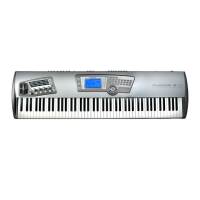ALESIS FUSION
ANALOG SYNTHESIS TUTORIAL
CONTROLLERS
Before we look at the various controllers, we are going to take a trip
back in time to take a basic
lesson in ‘voltage control’ because with an understanding of how synths used to work, we can
better understand how controllers work in a modern environment.
Today, the late Dr Robert Moog is largely regarded as the father of
modern synthesisers.
However, synthesisers and electronic music
had been around in one form or another for a
some time before Moog brought
his products to the market. However, these were often test
laboratory
oscillators and graphic equalisers, ring modulators, simple tape delays, etc., and
early electronic music pioneers had
to record small snippets of sounds created with this
equipment and, using tape splicing
techniques, painstakingly ‘assemble’ a piece of electronic
music. It was
a laborious and time-consuming affair as you can imagine and a few seconds of
electronic music could take days to make!!
What Moog did was ‘rationalise’ the process: by splitting the various
elements of sound into
different components such as
we have so far discussed - sound generators and sound
processors.
However, what was unique to Moog’s synthesisers was voltage control which
allowed predictable control of these different components (such as
pitch, waveshape, tone,
amplitude, etc.)
5
.
The idea is simple - apply a varying voltage to the control input
of an oscillator and the pitch will
change; apply a varying voltage to the cutoff frequency
of a filter and the tone will change;
apply a varying voltage to the control input of an amplifier and the amplitude/level will change.
Also, Moog devised the idea of the 1Volt/Octave (1V/8ve)
rule - i.e. if the voltage doubles, so
does the pitch of the oscillator (or the frequency of the filter’s cutoff or the amplifier’s
output
level):
5
Another synth pioneer, Don Buchla, was also working in similar areas at
the time. However, his
designs were maybe a bit more esoteric
and aimed more at ‘avante garde’ composers. His
synths also used voltage control but they didn’t always
conform to a predictable ‘standard’ like
Moog’s.
Controllers
Page
19

